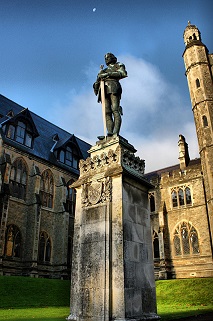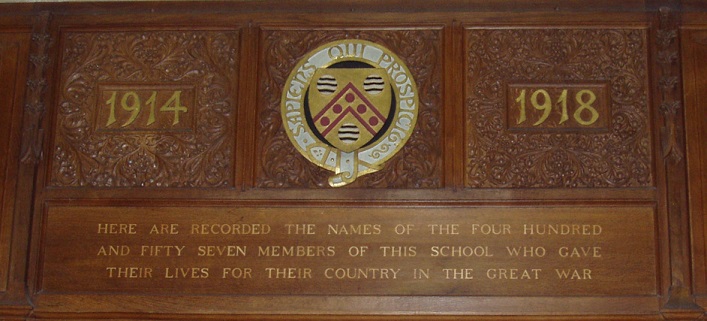



The following is a list with biographies of the 462 people who attended Malvern College and died due to the First World War. Altogether 2,833 are known to have served. There is also a corresponding page commemorating the 249 casualties in the Second World War.
There was not a month from August 1914 to November 1918 that an Old Malvernian did not become a casualty, with 6 killed on the first day of the Battle of Loos on the 25th September 1915 and 13 killed on the first day of the Battle of the Somme on the 1st July 1916.
The vast majority of casualties occurred in France and Belgium with 31 names recorded on the Menin Gate at Ypres, and 23 at Thiepval. There were also 23 casualties in Turkey due to the Gallipoli Campaign, and 16 in Iraq, including 2 near Kut.
They were in a wide range of regiments including 26 in the Royal Field Artillery, 13 in the Royal Engineers, 12 in the Worcestershire Regt, 11 in the Canadian Inf, 11 in the East Kent Regt (The Buffs), and 5 in the Royal Flying Corps and the Royal Air Force.
Most were officers with 133 Captains, 126 2nd Lieutenants, 114 Lieutenants, 26 Majors, and 15 Lieutenant Colonels.
29 received the MC, 10 the DSO and 1 the DCM, as well as 3 knighthoods (the CB, CMG, and MVO).
The information below is based primarily on the memorial books held at Malvern College which Ian Quickfall, and now Paul Godsland, the Malvernian Society archivists, have arranged to be digitised with the official memorial web site still in development.
Further information was also obtained from 'The Malvern College Register 1865-1924' edited by H.G.C Salmon, 'The Malvernian' school magazine, 'A History of Malvern College 1865 to 1965' by Ralph Blumenau, and 'Malvern College: A 150th Anniversary Portrait' by Roy Allen.
Information was also obtained from the Commonwealth War Graves Commission website, the Unit War Diaries and Service Records held at the National Archives in Kew, and various online commemorative websites whose links have been provided.
The main battles have tried to be identified in which Old Malvernians died in. Many though were killed in the general attrition of Trench Warfare which is so vividly described in the book 'Nothing of Importance' by Bernard Adams.
Below is a map showing the locations of the 246 cemeteries where Old Malvernians are buried or commemorated in. The markers are coloured yellow for one casualty, orange for between 2 and 9, and red for 10 or more. The name of the cemetery and number of casualties can be seen by hovering over the marker, and the list of names seen by clicking on the marker. Their full biographies and pictures can be seen by clicking on 'Further Info'.
The records can be filtered and/or sorted by name, house, age, regiment, battle, date, place etc by clicking on the appropriate drop down box and then the 'Search' button below the map. The original memorial book entry can be seen by clicking on the person's picture.
Born: 20th May 1896, 27 Longridge Road, Brompton, Kensington.
Father: The Hon Frederick Hugh Mackenzie Corbet (Barrister, Honorary Executive Officer for Ceylon at the Imperial Institute in 1896, Advocate General of Madras in 1914), College Bridge House, Egmore, Madras.
Mother: Eila Louise Mary Corbet formerly Campbell.
Brother: Reginald Vincent Corbet who was also at Malvern and was killed in action.
Sister: Constance Eila Corbet.
Education: King's College School Wimbledon 1909-1912, Malvern College 1912-1914.
Army III—II. House Prefect.
R.M.C. Sandhurst; Welch Regt. 1915.
Address: 4 College Grounds, Gt Malvern in 1912; The Newton Hotel, Newton Porthcawl, Glamorgan at time of probate.
'He joined his Battalion at the front in Flanders in April 1915, and was immediately engaged in the second battle of Ypres. On May 9th he was very severely wounded by shrapnell in the shoulder and throat. After a series of operations, which he bore with characteristic courage and cheerfulness, he seemed to be making a good recovery, and letters from him last autumn spoke hopefully of a return to active service. In December he was attached for light duty to the 21st Middlesex Regt., but the trouble in the throat necessitated further operations, and he died in London on Jan. 29th. His happy and affectionate nature won him many friends here. We share the grief of his parents, who have lost both their sons in the war.' (Malvernian, Mar 1916).
He died at 2.45am on 25th January 1916 at Lady Ridley's Hospital, 10 Carlton House Terrace where he had been periodically since June 10th 1915 after previously being in No 7 Stationary Hospital, Boulogne, as a result of wounds received in action from a shell wound in the neck on May 7th 1915 at Ypres.
From 1st Welsh Regiment War diary:
7th May 1915, Ypres. Arrived GHQ line in support 4am & stood to as heavy firing heard. Shelled at intervals all day.
At 10pm 'A' Coy sent out to dig & hold trench on left of NF.
8th May. Strong German attack on our trenches. Left & centre of 83rd Bde broken by concentrated shell fire, leaving right of 84th Bde exposed. Germans forced a way in & worked up 84th Bde by enfilade fire assisted by heavy bombardment in front. Bn occupied GHQ line.
9th May. In GHQ lines. Very heavy shelling 3-5pm but very few casualties.
The dedication on the book 'Tell England' by Ernest Raymond reads as follows:
'To the Memory of Reginald Vincent Campbell Corbet who fell, while a boy, in the East and George Frederick Francis Corbet who passed, while a boy, in the West is affectionately dedicated what little is best in this book, nothing else in it being worthy of them. '
Ref:Invision Zone forum
Service record:WO 339/2697
War Diary 1 Welch Regiment:WO-95-2277-4
Wikipedia:Tell England
Son of Hon. F H M Corbet, Madras. Born:1894. Brother to George Frederick Francis Corbet.
Middle IV A—Army II. School Prefect. Head of House. Champion Athlete. House XI Football. Cadet Officer.
R.M.C. Sandhurst; 1st Bn. Royal Dublin Fusiliers 1914; Lieutenant 1915.
'At Sandhurst he was appointed a Cadet Officer and obtained a Blue for Running. In Jan. I914 he was commissioned to the 2nd Bn. of the Royal Dublin Fusiliers, and in July was transferred to the 1st Bn. at Madras. In March of this year he was promoted Lieutenant and was made second officer in charge of the Machine Gun Section. He was killed in action at the Dardanelles on April 28th. He was a boy of an affectionate nature and many sympathies, shown not only among school-fellows but also in the social work to which he devoted part of his holidays, and his power as a leader combined with a striking natural courtesy rendered him an exceptionally successful Head of his House. ' (Malvernian, Jun 1915).
Medal card: WO 372/5/22337